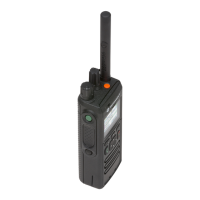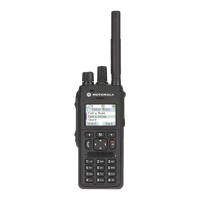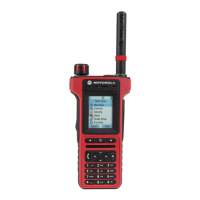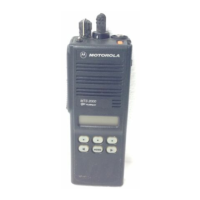Do you have a question about the Motorola MTP3250 and is the answer not in the manual?
Explains graphic icons used in documentation for visual cues and warnings.
Details special notations used in the guide to highlight information and menu navigation.
States that the guide covers all features, but service provider customization may vary.
Provides technical specifications for the radio, including voltage, current, power, and operating times.
Instructions for initial radio setup: attaching antenna, inserting SIM card, installing/removing battery.
Details all physical controls, buttons, and indicators on the MTP3x50 radio model.
Procedure for turning the radio on and the initial self-check and registration routine.
Information on entering text messages, including text entry modes and methods.
Explains PIN code authentication for radio security and unauthorized use prevention.
Describes the radio's display elements, including status icons and soft key areas.
Details various status icons indicating radio activities, features, and network status.
Guidance on how to hold the radio for optimal microphone and earpiece use during calls.
Procedures for manually selecting talkgroups and understanding talkgroup icons.
Details features that can be activated by a long key press of programmable buttons.
Describes Trunked Mode Operation (TMO) for voice and data communication via infrastructure.
Explains how network operators dynamically manage talkgroups over the air interface.
Details broadcast calls initiated from console or radio, pre-empting lower priority calls.
Allows calling landline, mobile numbers, or office extensions within Trunked Mode.
How service providers can modify call priority, type, and encryption during an active call.
Describes Fallback Mode for site-to-site communication when central link fails.
Details simplex radio-to-radio communication without network infrastructure.
Allows superiors to take over ongoing group calls with preemptive priority calls.
Disables radio transmissions in RF sensitive areas, except for emergency calls.
Covers emergency services activation, call types, and procedures during critical situations.
Initiates a high-priority broadcast emergency call for catastrophic situations.
Enables repeater connectivity for extending DMO range by retransmitting information.
Instructions on how to navigate and select items within the radio's main menu.
Explains menu icons to easily identify menu items at first glance.
Details on sending and receiving text messages, including status and store/forward options.
Describes the inbox folder for incoming messages, including icons and reading procedures.
Details the outbox for sent messages, including icons and delivery status.
Explains the Call-Out box for incoming and outgoing messages and associated icons.
Covers user-defined and predefined message templates for quick message sending.
Details on sending status and targeted status messages to talkgroups or private numbers.
Allows sending messages/reports to defined recipients, with options to add/edit/delete.
Information on storing, creating, editing, and deleting contact entries and numbers.
Details on Bluetooth settings, pairing devices, and managing connected devices.
Covers PIN protect, keypad lock, and air encryption settings for radio security.
Explains how to verify the validity of the infrastructure's secret key for authentication.
Details Static Cipher Keys for encrypting calls and data in TMO and DMO modes.
Enables complete suppression of alerts and notifications for unnoticeable radio operation.
Describes remote control types (SDS, Status) and how to assign tasks remotely.
Allows general configuration of the radio, including ring style, volume, and language.
Configures radio for transmitting/receiving data with external devices in TMO mode.
Adjusts radio audio settings, including audio profiles, howling suppression, and volume.
Manages tone settings like keypad tones, talk permit, clear-to-send, and periodic alerts.
Adjusts display settings such as flip display, font level, backlight, and screen saver.
Controls displayed time and date format, manual setting, and automatic updates.
Mode for saving battery life by reducing monitoring of downlink time slots.
Allows selecting transmit power class (Class 3L or Class 4) for signal strength.
Connects and configures accessories like IMPRES, CORE, and Bluetooth headsets.
Sets functionality for Volume Knob and Talkgroup Knob, including lock and wrap-around.
Resets the radio back to its original default settings.
Sets operation parameters, scanning, and manages favorite groups and talkgroups.
Activates/deactivates talkgroup scanning, views scan lists, and edits talkgroups.
Allows selecting/editing favorite group lists, including adding and managing folders.
Sets call settings for individual calls, including call waiting and call forwarding.
Provides shortcuts to frequently used talkgroups and contacts organized in favorite folders.
Allows viewing history of dialed, received, and missed calls.
Enables setting up shortcuts to access frequently used menu items.
Allows switching between radio operation modes and selecting networks.
Enables GNSS, changes accuracy, views position, and accesses test pages.
Details Packet Data service for data transfer and viewing data statistics/encryption status.
Manages SIM card based End-to-End Encryption for voice, messages, and data.
Allows dispatcher to listen to conversations via a special call, preempting other calls.
Wireless technology for personal networks, supporting audio, connectivity, and sensors.
How Bluetooth interacts with other features like Covert Mode, TXI, and wired accessories.
Makes the radio visible to other Bluetooth devices for connection requests.
Procedure for adding audio devices and configuring sensor devices via codeplug.
Instantly connects radio with Bluetooth Low Energy (BTLE) devices like sensors.
Displays sensor information like battery level, heart rate, and sensor alarms.
Manages text messages in a circular buffer, with notifications and saving options.
Allows receiving Call-Out alerts, interrupting services and entering Call-Out mode.
Describes five types of Call-Out alerts, including Normal, Storm Plan, and Test Call-Out.
Explains how Call-Out feature operates differently in TXI, TMO, DMO, and Emergency Modes.
Uses GNSS satellites to determine radio location, assisting dispatch and resource deployment.
Guidelines to maximize GNSS location fix accuracy, like staying in open areas.
Records location tracks when out of service, in DMO, or TXI mode, uploading when back.
Point-to-point calls between two TETRA radios: Private, Phone, and PABX calls.
Enables private, point-to-point communication, with Duplex and Simplex call types.
Allows calling landline, mobile numbers, or office extensions in Trunked Mode.
Adds ISDN number to radio for addressing calls and messages using MS-ISDN or ISSI.
Allows calling by pressing and holding keys (1-9) for quick dialing.
Allows receiving and sending RMS messages via SDS-TL or Status transport layers.
Enables authentication service for full access and permanent radio functionality.
Explains interactions with SIM cards for End-to-End Encryption, supporting BSI feature.
Allows dialing part of a full number, with the radio automatically completing it.
Attaches to talkgroups by dialing their index, also known as Talkgroup Speed Dial.
Allows service provider to permanently disable radio if stolen or lost.
Allows temporary disabling/enabling of radio by service provider if stolen.
Standard for network communications, enabling mobile web access via WAP browser.
Openwave Mobile Browser for basic web browsing services in TMO mode.
Steps to create bookmarks by marking pages and saving them.
Procedure to create new bookmarks and folders within the Bookmarks pane.
How to access saved bookmarks and download pages from the web.
Assigns hotkeys to bookmarks for quick access to bookmarked pages.
Instructions to save web pages for offline browsing within the Bookmarks folder.
How to select and view saved pages from the browser's Saved Pages folder.
Conditions under which browser entry is disabled, such as during calls or PIN lock.
Details key press actions for navigation, editing, and browser menu interactions.
Overview of browser menu panes like Navigate, Bookmarks, History, and Tools.
Options within the Navigate pane for loading pages, entering URLs, and managing bookmarks.
Advanced browser settings including downloads, scroll mode, proxy, and security.
Manages bookmarks and saved pages, allowing options like edit, delete, and create new.
Procedures for managing saved pages, including updating, deleting, and viewing details.
Displays a list of recently visited pages and allows navigation to URLs.
Provides access to applications and utilities like showing URL, saving page, finding text.
Allows inputting text for URLs, with different modes for characters, numbers, and HTTP.
Allows WAP content to be pushed to the radio, supporting encoded messages with WAP addresses.
Procedure to view WAP messages in the browser, with options for priority and display.
Guidelines for storing Lithium-Ion batteries, recommending cool, dry areas.
Recommends replacing batteries with genuine Motorola Solutions replacements for maximum life.
Specifies the temperature range for battery charging (0°C to +45°C) to ensure full charge.
Safety warnings for batteries: avoid metal objects, do not disassemble, or throw in fire.
Advice on handling the radio: avoid extreme temperatures, water immersion, and clean with cloth.
Explains graphic icons used in documentation for visual cues and warnings.
Details special notations used in the guide to highlight information and menu navigation.
States that the guide covers all features, but service provider customization may vary.
Provides technical specifications for the radio, including voltage, current, power, and operating times.
Instructions for initial radio setup: attaching antenna, inserting SIM card, installing/removing battery.
Details all physical controls, buttons, and indicators on the MTP3x50 radio model.
Procedure for turning the radio on and the initial self-check and registration routine.
Information on entering text messages, including text entry modes and methods.
Explains PIN code authentication for radio security and unauthorized use prevention.
Describes the radio's display elements, including status icons and soft key areas.
Details various status icons indicating radio activities, features, and network status.
Guidance on how to hold the radio for optimal microphone and earpiece use during calls.
Procedures for manually selecting talkgroups and understanding talkgroup icons.
Details features that can be activated by a long key press of programmable buttons.
Describes Trunked Mode Operation (TMO) for voice and data communication via infrastructure.
Explains how network operators dynamically manage talkgroups over the air interface.
Details broadcast calls initiated from console or radio, pre-empting lower priority calls.
Allows calling landline, mobile numbers, or office extensions within Trunked Mode.
How service providers can modify call priority, type, and encryption during an active call.
Describes Fallback Mode for site-to-site communication when central link fails.
Details simplex radio-to-radio communication without network infrastructure.
Allows superiors to take over ongoing group calls with preemptive priority calls.
Disables radio transmissions in RF sensitive areas, except for emergency calls.
Covers emergency services activation, call types, and procedures during critical situations.
Initiates a high-priority broadcast emergency call for catastrophic situations.
Enables repeater connectivity for extending DMO range by retransmitting information.
Instructions on how to navigate and select items within the radio's main menu.
Explains menu icons to easily identify menu items at first glance.
Details on sending and receiving text messages, including status and store/forward options.
Describes the inbox folder for incoming messages, including icons and reading procedures.
Details the outbox for sent messages, including icons and delivery status.
Explains the Call-Out box for incoming and outgoing messages and associated icons.
Covers user-defined and predefined message templates for quick message sending.
Details on sending status and targeted status messages to talkgroups or private numbers.
Allows sending messages/reports to defined recipients, with options to add/edit/delete.
Information on storing, creating, editing, and deleting contact entries and numbers.
Details on Bluetooth settings, pairing devices, and managing connected devices.
Covers PIN protect, keypad lock, and air encryption settings for radio security.
Explains how to verify the validity of the infrastructure's secret key for authentication.
Details Static Cipher Keys for encrypting calls and data in TMO and DMO modes.
Enables complete suppression of alerts and notifications for unnoticeable radio operation.
Describes remote control types (SDS, Status) and how to assign tasks remotely.
Allows general configuration of the radio, including ring style, volume, and language.
Configures radio for transmitting/receiving data with external devices in TMO mode.
Adjusts radio audio settings, including audio profiles, howling suppression, and volume.
Manages tone settings like keypad tones, talk permit, clear-to-send, and periodic alerts.
Adjusts display settings such as flip display, font level, backlight, and screen saver.
Controls displayed time and date format, manual setting, and automatic updates.
Mode for saving battery life by reducing monitoring of downlink time slots.
Allows selecting transmit power class (Class 3L or Class 4) for signal strength.
Connects and configures accessories like IMPRES, CORE, and Bluetooth headsets.
Sets functionality for Volume Knob and Talkgroup Knob, including lock and wrap-around.
Resets the radio back to its original default settings.
Sets operation parameters, scanning, and manages favorite groups and talkgroups.
Activates/deactivates talkgroup scanning, views scan lists, and edits talkgroups.
Allows selecting/editing favorite group lists, including adding and managing folders.
Sets call settings for individual calls, including call waiting and call forwarding.
Provides shortcuts to frequently used talkgroups and contacts organized in favorite folders.
Allows viewing history of dialed, received, and missed calls.
Enables setting up shortcuts to access frequently used menu items.
Allows switching between radio operation modes and selecting networks.
Enables GNSS, changes accuracy, views position, and accesses test pages.
Details Packet Data service for data transfer and viewing data statistics/encryption status.
Manages SIM card based End-to-End Encryption for voice, messages, and data.
Allows dispatcher to listen to conversations via a special call, preempting other calls.
Wireless technology for personal networks, supporting audio, connectivity, and sensors.
How Bluetooth interacts with other features like Covert Mode, TXI, and wired accessories.
Makes the radio visible to other Bluetooth devices for connection requests.
Procedure for adding audio devices and configuring sensor devices via codeplug.
Instantly connects radio with Bluetooth Low Energy (BTLE) devices like sensors.
Displays sensor information like battery level, heart rate, and sensor alarms.
Manages text messages in a circular buffer, with notifications and saving options.
Allows receiving Call-Out alerts, interrupting services and entering Call-Out mode.
Describes five types of Call-Out alerts, including Normal, Storm Plan, and Test Call-Out.
Explains how Call-Out feature operates differently in TXI, TMO, DMO, and Emergency Modes.
Uses GNSS satellites to determine radio location, assisting dispatch and resource deployment.
Guidelines to maximize GNSS location fix accuracy, like staying in open areas.
Records location tracks when out of service, in DMO, or TXI mode, uploading when back.
Point-to-point calls between two TETRA radios: Private, Phone, and PABX calls.
Enables private, point-to-point communication, with Duplex and Simplex call types.
Allows calling landline, mobile numbers, or office extensions in Trunked Mode.
Adds ISDN number to radio for addressing calls and messages using MS-ISDN or ISSI.
Allows calling by pressing and holding keys (1-9) for quick dialing.
Allows receiving and sending RMS messages via SDS-TL or Status transport layers.
Enables authentication service for full access and permanent radio functionality.
Explains interactions with SIM cards for End-to-End Encryption, supporting BSI feature.
Allows dialing part of a full number, with the radio automatically completing it.
Attaches to talkgroups by dialing their index, also known as Talkgroup Speed Dial.
Allows service provider to permanently disable radio if stolen or lost.
Allows temporary disabling/enabling of radio by service provider if stolen.
Standard for network communications, enabling mobile web access via WAP browser.
Openwave Mobile Browser for basic web browsing services in TMO mode.
Steps to create bookmarks by marking pages and saving them.
Procedure to create new bookmarks and folders within the Bookmarks pane.
How to access saved bookmarks and download pages from the web.
Assigns hotkeys to bookmarks for quick access to bookmarked pages.
Instructions to save web pages for offline browsing within the Bookmarks folder.
How to select and view saved pages from the browser's Saved Pages folder.
Conditions under which browser entry is disabled, such as during calls or PIN lock.
Details key press actions for navigation, editing, and browser menu interactions.
Overview of browser menu panes like Navigate, Bookmarks, History, and Tools.
Options within the Navigate pane for loading pages, entering URLs, and managing bookmarks.
Advanced browser settings including downloads, scroll mode, proxy, and security.
Manages bookmarks and saved pages, allowing options like edit, delete, and create new.
Procedures for managing saved pages, including updating, deleting, and viewing details.
Displays a list of recently visited pages and allows navigation to URLs.
Provides access to applications and utilities like showing URL, saving page, finding text.
Allows inputting text for URLs, with different modes for characters, numbers, and HTTP.
Allows WAP content to be pushed to the radio, supporting encoded messages with WAP addresses.
Procedure to view WAP messages in the browser, with options for priority and display.
Guidelines for storing Lithium-Ion batteries, recommending cool, dry areas.
Recommends replacing batteries with genuine Motorola Solutions replacements for maximum life.
Specifies the temperature range for battery charging (0°C to +45°C) to ensure full charge.
Safety warnings for batteries: avoid metal objects, do not disassemble, or throw in fire.
Advice on handling the radio: avoid extreme temperatures, water immersion, and clean with cloth.
| Brand | Motorola |
|---|---|
| Model | MTP3250 |
| Category | Portable Radio |
| Language | English |











